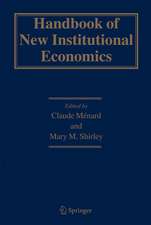Overlapping Structures as a Model of Money: An Analytical Review: Microeconomic Studies
Autor Bruno Schönfelderen Limba Engleză Paperback – 14 feb 2012
Preț: 640.24 lei
Preț vechi: 753.22 lei
-15% Nou
Puncte Express: 960
Preț estimativ în valută:
122.51€ • 131.01$ • 102.15£
122.51€ • 131.01$ • 102.15£
Carte tipărită la comandă
Livrare economică 18 aprilie-02 mai
Preluare comenzi: 021 569.72.76
Specificații
ISBN-13: 9783642457159
ISBN-10: 3642457150
Pagini: 256
Ilustrații: X, 242 p.
Dimensiuni: 170 x 244 x 13 mm
Greutate: 0.41 kg
Ediția:Softcover reprint of the original 1st ed. 1992
Editura: Springer Berlin, Heidelberg
Colecția Springer
Seria Microeconomic Studies
Locul publicării:Berlin, Heidelberg, Germany
ISBN-10: 3642457150
Pagini: 256
Ilustrații: X, 242 p.
Dimensiuni: 170 x 244 x 13 mm
Greutate: 0.41 kg
Ediția:Softcover reprint of the original 1st ed. 1992
Editura: Springer Berlin, Heidelberg
Colecția Springer
Seria Microeconomic Studies
Locul publicării:Berlin, Heidelberg, Germany
Public țintă
ResearchCuprins
1. Introduction.- 1.1. The “Integration of Monetary and Value Theory”.- 1.2. The Concept of an “Overlapping Structure”.- 1.3. The Purpose of this Book.- 2. The Overlapping Generation Model: An Overview.- 2.1. The Samuelson-Model.- 2.2. OGMs with Production and Capital.- 2.3. Generalizations of the Basic Model.- 2.4. The Interpretation of Indeterminacy.- 2.5. Concluding Remark.- 3. Overlapping Structures and Cash-In-Advance Constraints.- 3.1. Cass’ Theorems.- 3.2. The Analogy between the Samuelson Model and a Simple Cash-in-Advance Constraint Model.- 3.3. A Physical Structure which Generates Cash-in-Advance Constraints.- 4. The Rate of Return Paradox I: OGM with Transaction Costs.- 4.1. A Transaction Costs Model by Bryant and Wallace.- 4.2. Difficulties of Identifying Safe Assets and the Rate of Return Paradox.- 4.3. Baumol’s Inventory Model of Money.- 4.4. A Concluding Remark.- 5. The Rate of Return Paradox II: “Legal Restrictions”.- 5.1. “Legal Restrictions” in the FR Germany.- 5.2. Implications of the Legal Restriction Theory.- 5.3. Some Observations from Monetary History and the Present.- 5.4. Legal restrictions as an Expedient for Levying the Inflation Tax.- 5.5. Minimum Reserve Requirements and Indeterminacy.- 5.6. Minimum Sizes for Privately Issued Bearer’s Notes.- 5.7. Holding out the Prospect of Backing.- 5.8. Concluding Remark.- 6. Private Production of Outside Money.- 6.1. Competition between Private Producers of Fiat Money.- 6.2. Money as a Natural Monopoly.- 6.3. Gresham’s Law.- 6.4. Concluding Remark.- 7. Topics in Commodity Money Theory.- 7.1. A Model of a Gold Specie Standard.- 7.2. The Quantity Theory of Money.- 7.3. Uniqueness of Equilibrium.- 7.4. Restrictions on the Production of Inside Money.- 7.5. Commodity Money withoutReserves.- 8. A Few Macroeconomic Applications.- 8.1. A Model with Non-Interest Bearing Money and Interest-Bearing Public Debt.- 8.2. “Backed” and “Unbacked” Public Debt.- 8.3. A Simple Model with Cash-in-advance Constraints and Credit Goods.- 8.4. The Distinction between Outside and Inside Money.- 8.5. The Fisher Effect.- 8.6. Grandmont-Policy.- 9. Monetary Policy in The Open Economy.- 9.1. The Kareken and Wallace Model.- 9.2. Stabilizing and Destabilizing Speculation.- 9.3. Concluding Remark.- 10. Summary and Conclusions.- 10.1. Summary.- 10.2. Conclusions.
























